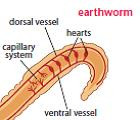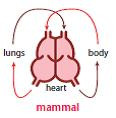Mass Transport Systems
Why do most multicellular organisms need a mass transport system?
The bigger an organism is, the lower its surface area to volume ratio. Substances needed by a large organism could not be supplied through its exposed external surface. Oxygen passing through an external surface would be rapidly used up before reaching the many layers of underlying cells. Similarly waste substances would not be excreted quickly enough. This problem has been solved, through evolution, by specially adapted tissues and organs.
The Mass Transport System is like transport on trains where people travel together on the same train, in the same direction, at the same speed, but may get off at different places.
In a mass transport system, all the substances move in the same direction at the same speed. Across the range of multicellular organisms found in the living world are a number of mass transport systems, e.g. the mammalian circulatory system and the vascular system of a plant. Mass transport systems are just as important for the rapid removal of waste as they are for supplies. Supplies include an immense number of substances, e.g. glucose, oxygen and ions. Even communication from one cell to another can take place via a mass transport system, e.g. hormones in a blood stream. The greater the metabolic rate of an organism, the greater the demands on its mass transport system.
Different types of circulatory systems
Most organisms that are beyond a certain size have a circulatory system. These systems may be open or closed.
Insects have an open circulation. The blood is in the body cavity called the haemocoel. It does not circulate in blood vessels but a dorsal tube-shaped heart maintains movement of the blood in the chamber. Earthworms have a closed circulation. Five of the blood vessels act like hearts, pumping the blood through the main two blood vessels. In vertebrates, the pumping of the blood is performed by a specialised heart.
Fish have a single circulatory system. This means that the blood flows through the heart once on each circuit of the body.Mammals have a double circulatory system. This means that as blood enters the heart it is pumped to the lungs, exchanges carbon dioxide for oxygen, and returns to the heart where further pumping propels it through the rest of the body. The blood moves through the heart twice during each cardiac cycle.
In a single circulation, the blood has to pass through two capillary beds, one after the other. This makes blood flow more slowly compared with a double circulation.
IMAGES
|
Image

|
Image

|
|
Image

|
Image

|
|
KEY POINT - Leaves, roots, gills and lungs all have high surface area to volume properties so that supplies of substances vital to all the living cells are made available by these structures. Movement of substances to and from these structures is carried out by efficient mass transport systems. KEY POINT - In a closed circulation the blood is contained in blood vessels as it circulates. In an open circulation the blood is contained in the body cavity. KEY POINT - Vertebrate circulatory systems can be either single or double and this results in structural differences between their hearts. |
